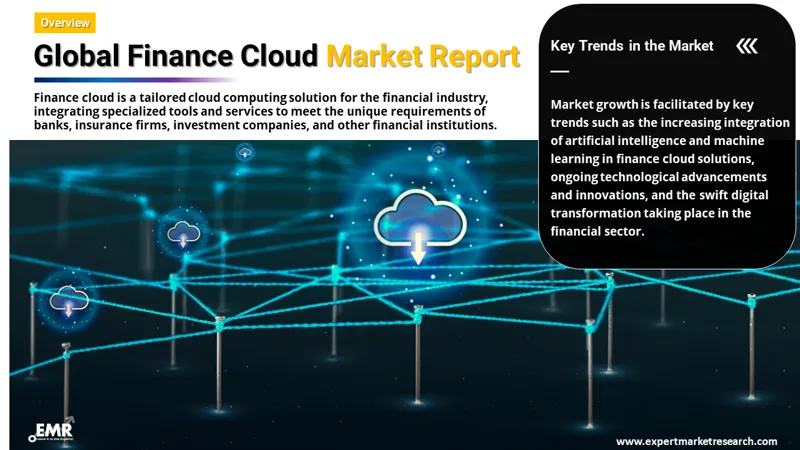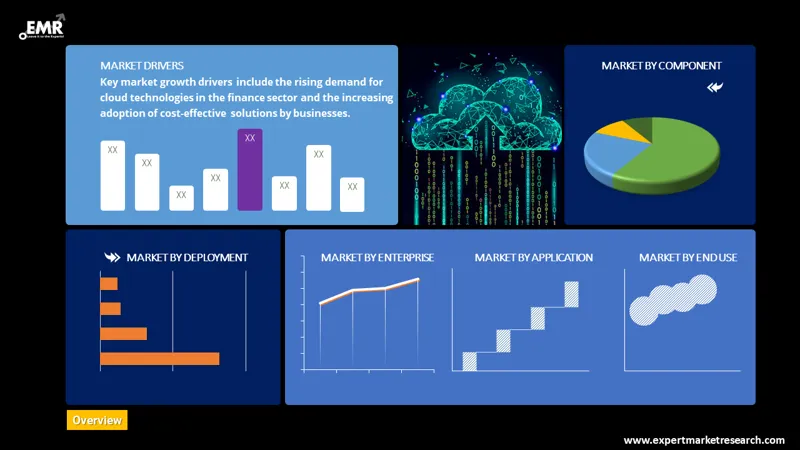
Consumer Insights
Uncover trends and behaviors shaping consumer choices today
Procurement Insights
Optimize your sourcing strategy with key market data
Industry Stats
Stay ahead with the latest trends and market analysis.
The global finance cloud market reached a value of approximately USD 36.44 Billion in 2025. The market is projected to grow at a CAGR of 16.40% between 2026 and 2035, reaching a value of around USD 166.38 Billion by 2035.
Base Year
Historical Period
Forecast Period
Compound Annual Growth Rate
16.4%
Value in USD Billion
2026-2035
*this image is indicative*
Finance cloud refers to a cloud computing solution specifically designed for the financial industry. It combines the benefits of cloud computing with specialised financial tools and services to meet the unique needs of financial institutions, such as banks, insurance companies, investment firms, and other financial service providers.

Read more about this report - REQUEST FREE SAMPLE COPY IN PDF
The EMR’s report titled “Finance Cloud Market Report and Forecast 2026-2035" offers a detailed analysis of the market based on the following segments:
Market Breakup by Component
Market Breakup by Deployment
Market Breakup by Enterprise
Market Breakup by Application
Market Breakup by End Use
Market Breakup by Region

Read more about this report - REQUEST FREE SAMPLE COPY IN PDF
The public cloud segment is expected to account for a major portion of the finance cloud market share. The segment growth is augmented by its cost-effective benefits as it enables businesses to only pay for the resources they use. This eliminates unnecessary expenses associated with maintaining idle resources. Furthermore, the public cloud offers businesses the flexibility to easily scale their resources up or down in response to fluctuations in demand.
The application of cloud technologies in wealth management is likely to generate a significant amount of market revenue. The significant surge in demand for cloud technology among wealth and investment management organisations is a major factor propelling the market growth. These firms are seeking efficient solutions to manage an increasingly demanding client base.
In addition, compliance with stringent regulations is a top priority for wealth management firms, and cloud technology provides advanced security measures and data protection capabilities, ensuring compliance with regulatory frameworks.
The comprehensive EMR report provides an in-depth assessment of the market based on the Porter's five forces model along with giving a SWOT analysis. The report gives a detailed analysis of the following key players in the global finance cloud market, covering their competitive landscape and latest developments like mergers, acquisitions, investments and expansion plans.
IBM Corporation, commonly referred to as IBM (International Business Machines Corporation), is a well-established American multinational technology company, established in 1911. The company has gone through developments and expanded its business endeavours into diverse sectors. It has become one of the leading figures in the finance cloud market, while also having a significant presence in the artificial intelligence (AI), blockchain technology, cybersecurity, and data analytics sectors, among others.
Microsoft Corporation is one of the leading technology companies, which is best known for its software products, particularly its operating systems. The company began its operation in 1975 and has developed its presence in multiple fields, including cloud computing and hardware, among many others. In the field of cloud computing, the company has established its place with its Microsoft Azure platform.
Oracle Corporation is a renowned multinational technology company based in the United States that specialises in an array of technology solutions, including database software, cloud engineering systems, and enterprise software products. With its establishment in 1977, Oracle has emerged as a prominent global technology firm, catering to diverse industries and customers worldwide. The company is particularly recognised for its flagship offering, the Oracle Database, which stands as a leading relational database management system (RDBMS).
*Please note that this is only a partial list; the complete list of key players is available in the full report. Additionally, the list of key players can be customized to better suit your needs.*
Other market players include Amazon Web Services, Inc., Acumatica, Inc., Aryaka Networks, Inc., Sage Group plc, SAP SE, and Salesforce, Inc., among others.




*While we strive to always give you current and accurate information, the numbers depicted on the website are indicative and may differ from the actual numbers in the main report. At Expert Market Research, we aim to bring you the latest insights and trends in the market. Using our analyses and forecasts, stakeholders can understand the market dynamics, navigate challenges, and capitalize on opportunities to make data-driven strategic decisions.*
Get in touch with us for a customized solution tailored to your unique requirements and save upto 35%!
In 2025, the market reached an approximate value of USD 36.44 Billion.
The market is projected to grow at a CAGR of 16.40% between 2026 and 2035.
The market is estimated to witness a healthy growth in the forecast period of 2026-2035 to reach around USD 166.38 Billion by 2035.
The major factors driving the market growth are the increasing demand for cloud technologies in the finance sector and the surging adoption of cost-effective solutions by businesses.
The key trends aiding the market growth are the rising implementation of artificial intelligence and machine learning in finance cloud solutions, technological advancements and innovations, and rapid digital transformation in the financial sector.
The major regional markets for finance cloud include North America, Europe, the Asia Pacific, Latin America, and the Middle East and Africa.
The different types of finance cloud include solution and services.
The key players in the finance cloud market include IBM Corporation, Microsoft Corporation, Oracle Corporation, Amazon Web Services, Inc., Acumatica, Inc., Aryaka Networks, Inc., Sage Group plc, SAP SE, and Salesforce, Inc., among others.
Explore our key highlights of the report and gain a concise overview of key findings, trends, and actionable insights that will empower your strategic decisions.
| REPORT FEATURES | DETAILS |
| Base Year | 2025 |
| Historical Period | 2019-2025 |
| Forecast Period | 2026-2035 |
| Scope of the Report |
Historical and Forecast Trends, Industry Drivers and Constraints, Historical and Forecast Market Analysis by Segment:
|
| Breakup by Component |
|
| Breakup by Deployment |
|
| Breakup by Enterprise |
|
| Breakup by Application |
|
| Breakup by End Use |
|
| Breakup by Region |
|
| Market Dynamics |
|
| Competitive Landscape |
|
| Companies Covered |
|
Datasheet
One User
USD 2,499
USD 2,249
tax inclusive*
Single User License
One User
USD 3,999
USD 3,599
tax inclusive*
Five User License
Five User
USD 4,999
USD 4,249
tax inclusive*
Corporate License
Unlimited Users
USD 5,999
USD 5,099
tax inclusive*
*Please note that the prices mentioned below are starting prices for each bundle type. Kindly contact our team for further details.*
Flash Bundle
Small Business Bundle
Growth Bundle
Enterprise Bundle
*Please note that the prices mentioned below are starting prices for each bundle type. Kindly contact our team for further details.*
Flash Bundle
Number of Reports: 3
20%
tax inclusive*
Small Business Bundle
Number of Reports: 5
25%
tax inclusive*
Growth Bundle
Number of Reports: 8
30%
tax inclusive*
Enterprise Bundle
Number of Reports: 10
35%
tax inclusive*
How To Order

Select License Type
Choose the right license for your needs and access rights.

Click on ‘Buy Now’
Add the report to your cart with one click and proceed to register.

Select Mode of Payment
Choose a payment option for a secure checkout. You will be redirected accordingly.
Gain insights to stay ahead and seize opportunities.

Get insights & trends for a competitive edge.

Track prices with detailed trend reports.

Analyse trade data for supply chain insights.

Leverage cost reports for smart savings

Enhance supply chain with partnerships.

Connect For More Information
Our expert team of analysts will offer full support and resolve any queries regarding the report, before and after the purchase.
Our expert team of analysts will offer full support and resolve any queries regarding the report, before and after the purchase.
We employ meticulous research methods, blending advanced analytics and expert insights to deliver accurate, actionable industry intelligence, staying ahead of competitors.
Our skilled analysts offer unparalleled competitive advantage with detailed insights on current and emerging markets, ensuring your strategic edge.
We offer an in-depth yet simplified presentation of industry insights and analysis to meet your specific requirements effectively.
Share